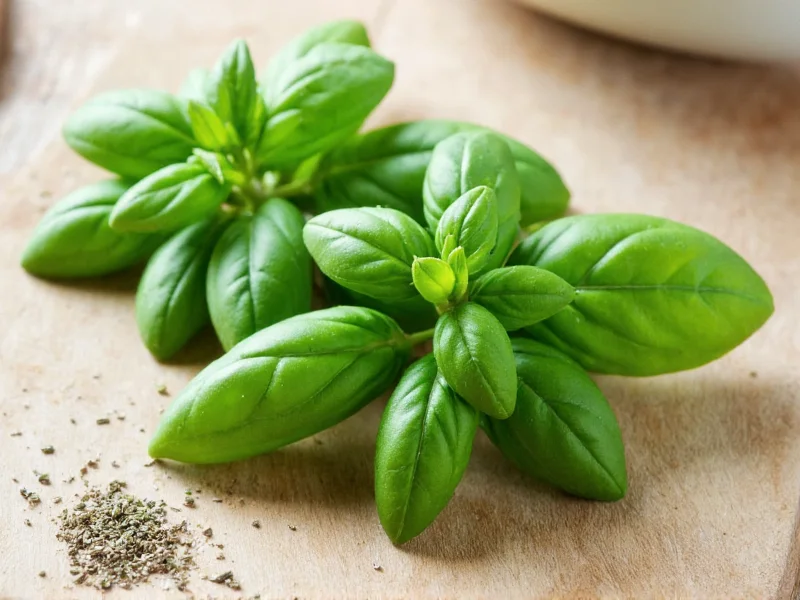Understanding how to properly substitute dried basil for fresh is essential for maintaining flavor balance in your cooking. Many home chefs make the mistake of using equal amounts, resulting in dishes that taste either too weak or overwhelmingly herbal. The key to successful substitution lies in recognizing the fundamental differences between fresh and dried herbs.
Why the 1:3 Ratio Works Best
Fresh basil contains approximately 90% water, which evaporates during the drying process. This concentration effect means dried basil delivers more intense flavor in a smaller volume. The essential oils that give basil its distinctive aroma and taste become more potent when water content decreases. Professional chefs and food scientists consistently recommend the 1:3 ratio as the most reliable conversion for basil and most other leafy herbs.
Precise Conversion Measurements
| Recipe Calls For (Fresh Basil) | Substitute With (Dried Basil) | Best Application |
|---|---|---|
| 1 cup chopped | ⅓ cup | Long-simmered sauces, soups |
| ½ cup | 3 tablespoons | Marinades, dressings |
| ¼ cup | 1½ tablespoons | Casseroles, baked dishes |
| 2 tablespoons | 2 teaspoons | Quick sauces, finishing touches |
| 1 tablespoon | 1 teaspoon | Most standard recipe adjustments |
Flavor Profile Differences to Consider
While the 1:3 ratio provides the correct intensity, dried and fresh basil offer distinct flavor experiences. Fresh basil delivers bright, sweet notes with hints of anise and pepper, while dried basil develops earthier, more muted characteristics with subtle mint undertones. The drying process alters volatile compounds, creating a different aromatic profile.
When substituting dried for fresh, consider these flavor adjustments:
- Add dried basil earlier in cooking to allow flavors to bloom
- Reconstitute dried basil in warm water or oil before use for more fresh-like flavor
- Finish dishes with a small additional pinch of dried basil just before serving
- Consider adding complementary herbs like oregano to enhance complexity
When Substitutions Work Best (and When They Don't)
Certain dishes handle basil substitutions better than others. Understanding these contexts helps you decide when to make the switch and when to seek alternatives:
Ideal for dried basil substitution:
- Long-cooked tomato sauces (simmered 30+ minutes)
- Hearty soups and stews
- Braised meats and vegetable dishes
- Baked casseroles and lasagnas
- Marinades requiring extended soaking time
Best to use fresh basil:
- Pesto and other raw herb sauces
- Caprese salad and fresh tomato dishes
- Garnishes and finishing touches
- Short-cooked stir-fries
- Cocktail garnishes and infused beverages
Pro Tips for Perfect Substitution Results
Professional chefs employ several techniques to maximize flavor when substituting dried basil for fresh:
- Crush before use: Rub dried basil between your palms to release essential oils before adding to dishes
- Layer flavors: Add half the dried basil early in cooking, the remainder near the end
- Temperature matters: Add dried herbs to warm (not boiling) liquids to prevent bitterness
- Storage check: Older dried herbs lose potency—replace if older than 1 year for accurate substitution
- Acid balance: A splash of lemon juice can brighten dishes using dried basil substitutions
Alternative Solutions When Dried Basil Falls Short
Sometimes dried basil simply won't deliver the fresh flavor profile you need. Consider these alternatives:
- Herb blending: Combine dried basil with equal parts dried oregano and a pinch of dried mint
- Freeze-dried options: High-quality freeze-dried basil offers closer flavor to fresh
- Herb-infused oil: Steep dried basil in warm olive oil for 20 minutes before using
- Alternative fresh herbs: Try parsley with a pinch of mint when basil is unavailable
Common Questions About Basil Substitution
Can I use the same amount of dried basil as fresh in recipes?
No, using equal amounts will result in overpowering flavor. The standard conversion is 1 teaspoon dried basil for every 1 tablespoon fresh basil (a 1:3 ratio). Dried herbs are more concentrated because the drying process removes water while preserving essential oils, making them approximately three times stronger than fresh herbs.
How do I adjust cooking time when using dried basil instead of fresh?
Add dried basil earlier in the cooking process—typically at the beginning or middle stages—rather than at the end like fresh basil. This allows time for the dried herb to rehydrate and release its flavors fully. For best results, incorporate dried basil when adding other dried spices, about 15-20 minutes before the dish finishes cooking.
Does the quality of dried basil affect substitution ratios?
Yes, older dried basil loses potency over time. Basil stored longer than 12-18 months may require slightly more than the standard 1:3 ratio. To test potency, rub a small amount between your fingers—if the aroma is weak, you may need to increase the quantity by 25-50%. Always store dried herbs in airtight containers away from light and heat to maintain maximum flavor.
Can I reconstitute dried basil to make it taste like fresh?
Partially. Soak dried basil in warm water or olive oil for 10-15 minutes before use to help restore some texture and release flavors. While this won't perfectly replicate fresh basil's bright notes, it creates a closer approximation than using dried basil directly. For best results, use 1 teaspoon dried basil with 1 tablespoon warm liquid per tablespoon of fresh basil called for in your recipe.
What's the best way to substitute dried basil in pesto?
Dried basil doesn't work well in traditional pesto due to its different texture and flavor profile. Instead, create a modified version using 2 teaspoons dried basil, 1 cup pine nuts, 2 garlic cloves, ½ cup Parmesan, and ½ cup olive oil. Add a pinch of dried mint to mimic fresh basil's complexity. For better results, consider using frozen fresh basil cubes if available, as dried basil lacks the vibrant character essential to authentic pesto.











 浙公网安备
33010002000092号
浙公网安备
33010002000092号 浙B2-20120091-4
浙B2-20120091-4